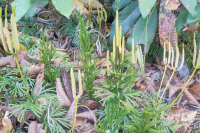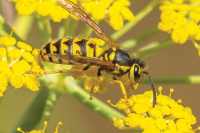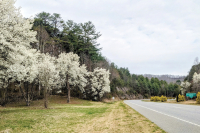Wildlife Commission reaffirms support for hunting with dogs
The Commissioners of the N.C. Wildlife Resources Commission unanimously adopted a resolution recently reaffirming the agency’s longstanding support for hunting with the use of dogs.
“We support the use of dogs in hunting in North Carolina where such hunting is consistent with the sound conservation of our state’s treasured wildlife resources and not contrary to the protection of the private property rights of its citizens,” said Gordon Myers, executive director of the commission. “Hunting with dogs is part of a centuries old tradition in North Carolina and the members of the Wildlife Resources Commission determined that it was important to clarify their position regarding those practices.”
The partnership of hunters and hunting dogs, commissioners affirmed, has long been a central thread of North Carolina hunting culture, and thousands of hunters – young and old – use dogs to pursue grouse and quail, waterfowl and woodcock, deer and bear, rabbits and squirrels, and foxes and bobcats, and raccoons and opossums.
“The members of the Wildlife Resources Commission looks forward to continuing its successful record of working with multiple partners to provide opportunities for hunters to use dogs on state and private lands where feasible and appropriate,” said Commission Chairman Steve Windham.
For more information on hunting in North Carolina or for a copy of the resolution, visit www.ncwildlife.org.
WildSouth facilitates wildlife meeting
The non-profit grassroots conservation organization WildSouth sponsored a meeting last week to discuss complaints and questions from the public regarding poaching, trespassing and other wildlife-related issues.
The meeting, held in the Harrell Center at Lake Junaluska on Jan. 7, attracted about 30 people including private citizens, members of the North Carolina General Assembly, representatives of the Western North Carolina Sportsman’s Club, representatives from the Southern Appalachian Multiple Use Council, law enforcement personnel, members of North Carolina Wildlife Resources Commission Division of Enforcement and NCWRC biologists.
According to Ben Prater, associate executive director of Wild South — which has offices in Asheville and Moulton, Ala. — the meeting was organized with the aid of John Edwards of Cashiers, organizer of the annual Mountain Wildlife Days and Wild South’s wildlife outreach coordinator.
Prater said the Wild South had been in contact with enforcement agencies and members of the General Assembly with regards to meeting needs in view of significant budget shortfalls.
Captain Greg Daniels of the NCWRC Division of Enforcement spoke to the group about some of the issues as they related to his department. Daniels said that poaching incidents appeared to be down this fall. “Mother nature did us a big favor,” he said.
Daniels said that the abundant mast crop this year “kept the deer in the woods.” Daniels also said there was a decline in big game hunting this year and felt like that could possibly be attributed to the poor economy.
But Daniels said the big news in the enforcement division was the budget and new leadership in Raleigh.
“The budget is definitely a pressing issue and will require us to take a fresh look at the way we do business,” Daniels said.
He said there would be some streamlining in the hierarchy, cutting some of the administrative positions and putting more officers in the field. Another new move by the division is marking some of their vehicles.
“We’ve spent most of our career hidden. Now we are marking some of our vehicles. We think people want to see their wildlife officers,” Daniels said.
But, he said, it was going to be a tough balancing act with only a couple of agents per county and the need for covert operations in dealing with large-scale poaching.
When one of the attends said he felt it was unacceptable to have three biologists positions unfilled, Rep. Ray Rapp (D-Mars Hill) said there was little chance of resolving that problem right now.
“That $3.7 billion (budget) shortfall is real. There are going to be painful cuts, filling positions is not likely,” Rep. Rapp said.
Meeting undertow
A strong contingent of hunters present felt that management or, in their minds, mismanagement of North Carolina’s national forest lands — particularly the absence of logging — was perhaps the largest bane to North Carolina’s wildlife.
In a short interview, Steve Henson, executive director of the Southern Appalachian Multiple Use Council, said it was impossible to talk about wildlife issues in the state without talking about the management of North Carolina’s national forests. He said that the dramatic decline of timber harvesting in the national forests, brought about by litigation from environmental organizations, was a major problem.
“It’s a big issue,” he said, “it’s been scientifically documented that the lack of early successional habitat is responsible for a decline in wildlife populations.”
Henson said Wild South had ulterior motives for calling the meeting. He said that with the Forest Service plan revision coming up in a year or so that Wild South was trying to position itself to be in a place to say they speak for the sportsmen of North Carolina.
“They don’t speak for me,” Henson said.
In an interview after the meeting, Prater flatly denied the allegations. “I can assure you and, hopefully, assure the public that Wild South is not looking to lead the Forest Service in any direction. We have worked with the Forest Service and the public for 20 years to help see that the national forests are managed in the best interest of everyone.
“We’re all about empowering people to make wise decisions. If I had my druthers, I would rather have not seen the discussion go in that direction. National Forest Service issues are so complicated. There’s not much we can do but try and work with the Forest Service in a collaborative way.”
Prater said he had hoped to stay focused on enforcement, education and human/wildlife conflict issues, but noted that because the meeting was public and habitat is a legitimate concern that he felt obligated “to provide people the opportunity to be heard.”
John Edwards said that the majority of Americans are non-hunters and that he believes there needs to be a forum where hunters and other wildlife advocates can have meaningful discussions about wildlife issues from different perspectives and all sides can be heard.
How do you feel?
Snow and icy conditions last kept a lot of people away from the meeting sponsored by Wild South, and that to try and include input from those people and other interested parties Wild South has created a survey and will use the information gleaned from the survey to plan its next meeting. To find out more about Wild South and/or WNC Wildlife Advocates, or to fill out the survey, visit www.wildsouth.org.
Headwaters tract deal hinges on Wildlife Commission
Kieran Roe, executive director of Carolina Mountain Land Conservancy, said that if the North Carolina Wildlife Commission does not commit to managing the East Fork Headwaters tract that the deal could fall through.
“There’s a lot riding on what Wildlife Resources decides,” she told The Smoky Mountain News in an interview this week.
Roe is guardedly optimistic that CMLC and its partner The Conservation Fund will be able to close on the property before the end of the year.
On CMLC’s website it states: “Funding for this project is not the chief issue. Carolina Mountain Land Conservancy and our partner, The Conservation Fund, have identified funding sources. While not guaranteed, the funders are unlikely to invest in East Fork Headwaters unless it enters the public domain. Given the high quality hunting and fishing on the tract, WRC is the most likely candidate for managing the tract. Note that WRC is not expected to take title to East Fork Headwaters immediately. The Conservation Fund will continue to own East Fork Headwaters for the time being until the total purchase price has been paid to the landowner. However, The Conservation Fund cannot make the initial $3 million down payment without the commitment of WRC to establish a game land and eventually take title to East Fork Headwaters. The Conservation Fund is not set up to own land indefinitely.”
The state Wildlife Resources Commission is playing it close to the vest. Chris McGrath, faunal diversity coordinator for the agency, said that Wildlife Commission biologists have been to the property, have consulted with the owners and potential buyers, and have assisted in assessing the merits of the property. He said the biologists have written reports detailing their findings for the director’s office, but that any management decisions would have to come from that office.
Geoff Cantrell, Wildlife Commission public information officer, would only say that the Headwaters tract was on the Land Use and Access Committee’s agenda for discussion on Wednesday, Nov. 3, and that the committee report would be on Thursday’s agenda.
Roe noted that Wildlife Commission was, “… not being asked, at this point, for any funding. We’re just asking them to work with us on managing the property.”
(Check online at www.smokymountainnews.com after Thursday’s Wildlife Resources Commission meeting for an update.)
Wildlife Commission Pledges Support for East Fork Headwaters
The Commissioners of the N.C. Wildlife Resources Commission unanimously passed a resolution Thursday, pledging the agency’s support for the management and stewardship of the East Fork Headwaters, an 8,000 acre tract of biologically diverse land in Transylvania County.
During meetings on Wednesday and Thursday, the Commission agreed to manage the land if the Conservation Fund raises the money to purchase it. The Conservation Fund, a nonprofit land protection organization, is under contract to purchase the East Fork Headwaters Tract for $33 million.
“This land is highly desirable for protection and public use, and is truly multipurpose,” said Gordon Myers, executive director of the Commission. “The N.C. Wildlife Resources Commission supports The Conservation Fund’s effort to effectuate long-term conservation of this valuable resource.”
The East Fork Headwaters tract is the largest privately owned tract remaining in far western North Carolina and is home to several waterfalls, 50 miles of trout streams and nearly 10 miles of the Foothills Trail where it enters North Carolina. The site contains exceptional recreational opportunities for public hunting, fishing, hiking and other outdoor pursuits. The land is also biologically valuable, containing habitats for a number of species listed in the Wildlife Action Plan.
The Commission cooperatively manages nearly 2 million acres through its game land program, providing valuable conservation stewardship and public access.
A copy of the resolution is available upon request.
No more daily bag limits for deer hunters this year
The Wildlife Commission has unveiled its proposed changes to hunting and fishing rules, but the list is a super short one this year and controversial proposals are markedly absent.
A public hearing on the proposed changes will be held at 7 p.m. Wednesday, Sept. 15, at Haywood Community College.
The list is a benign one compared to the past three years, which were all packed controversy.
A firestorm erupted last year over one of the proposed changes that would have weakened protection for the Smokies elk herd. While it is illegal to hunt elk, the change would have given landowners wider discretion to shoot an elk if it was causing private property damage.
The Wildlife Commission backed off and dropped the proposal following public outcry, however.
The previous year, public outcry temporarily sidelined a proposal to lift the daily bag limit for deer. While there is a still a cap on the number of deer a hunter can shoot over the course of hunting season, there is no longer a daily cap.
Hunters in the mountains protested, fearing the slacker rule would hurt the deer population.
The Wildlife Commission tabled the proposed change for a year, but has now enacted it anyway. This hunting season will be the first year it goes into effect.
The Wildlife Commission also caught flack over a proposal to allow falconry on Sundays and bow hunting on private land on Sundays. Hunting is otherwise illegal on Sundays. Critics feared the changes would open the door for full-blown Sunday hunting down the road.
The year before, a proposal to allow bear hunting with dogs in the popular Dupont State Forest recreation area in Henderson County was derailed by public outcry.
This year, there are no hunting rule changes that affect the mountains. There are only two fishing changes: one is to remove the “Public Mountain Trout Waters” designation on Ellijay Creek in Macon County, and the other is to clarify boundaries of the delayed harvest waters on the Tuck in Jackson County as between the N.C. 107 bridge and U.S. 441 bridge.
To comment, go to www.ncwildlife.org and click on “submit comments” on the right hand side.
— By Becky Johnson
Smokies not pleased with Wildlife Commission stance on elk
The North Carolina Wildlife Commission is at odds with the Great Smoky Mountains National Park over the status of the newly reintroduced elk herd.
The N.C. Wildlife Commission has come under fire for its plan to remove elk from the state list of species of special concern. As it scrambles to defend the delisting, the wildlife commission is pointing to a change in the herd’s status by the national park as the reason.
“From a biological perspective, with the information from the park we’ve gotten indicating they’ll declare the elk reintroduction a success, it means we don’t need to protect them with the special status,” said David Cobb, chief of the wildlife management division for the North Carolina Department of Environment and Natural Resources.
But that’s not exactly right, according to Bob Miller, a spokesperson for the Smokies. Miller said the park has not yet categorized the reintroduction of elk a success.
“We never told them the reintroduction program was a success,” Miller said. “What we told them is we have a population that is stable barring some kind of disaster or human intervention.”
The park does plan to change the herd’s status from an “experimental release” to an official “reintroduction” later this year. Under the experimental release status, the park was monitoring the herd closely to see whether they were a good fit for the ecosystem. The shift to an official “reintroduction” is different from declaring it a success, however.
Elk were reintroduced to the Cataloochee area of the Great Smoky Mountains National Park in 2001. Since then the initial herd of 52 animals has grown in size to 110 animals.
Miller said the park would submit a formal letter clarifying its position to the Wildlife Commission before the end of the public comment period.









